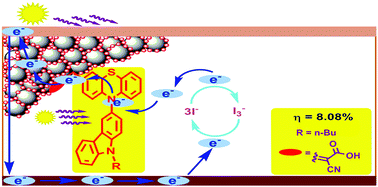Novel metal-free organic dyes possessing fused heterocyclic structural motifs for efficient molecular photovoltaics
Abstract
Reported herein are six novel metal free organic dyes such as PCA1–PCA3 and PCTA1–PCTA3 featuring fused heterocyclic structural motifs such as phenothiazine and alkylcarbazole. Photophysical/electrochemical properties and nanocrystalline TiO2 based dye-sensitized solar cell performance of the same have been investigated. Electronic distribution within the molecules has been determined through a computational approach. The overall power conversion efficiencies of the devices with the utilization of dyes PCA1–PCA3 and PCTA1–PCTA3 as sensitizers ranges between 4.67 and 8.08%. The novel dyes possessing cyanoacrylic acid as electron acceptor, PCA1–PCA3, exhibit higher power conversion efficiency, short-circuit current, open-circuit voltage, and electron lifetime those with thioxothiazolidinylacetic acid, PCTA1–PCTA3, as the same. Of the devices fabricated by employing the new metal-free organic sensitizers, that with the dye PCA2 exerted a power conversion efficiency (PCE, η) of 8.08% with a short circuit current density (JSC) of 16.45 mA cm−2, an open circuit voltage (VOC) of 735 mV and a fill factor (ff) of 0.68; this PCE is the highest amongst the devices fabricated.


 Please wait while we load your content...
Please wait while we load your content...